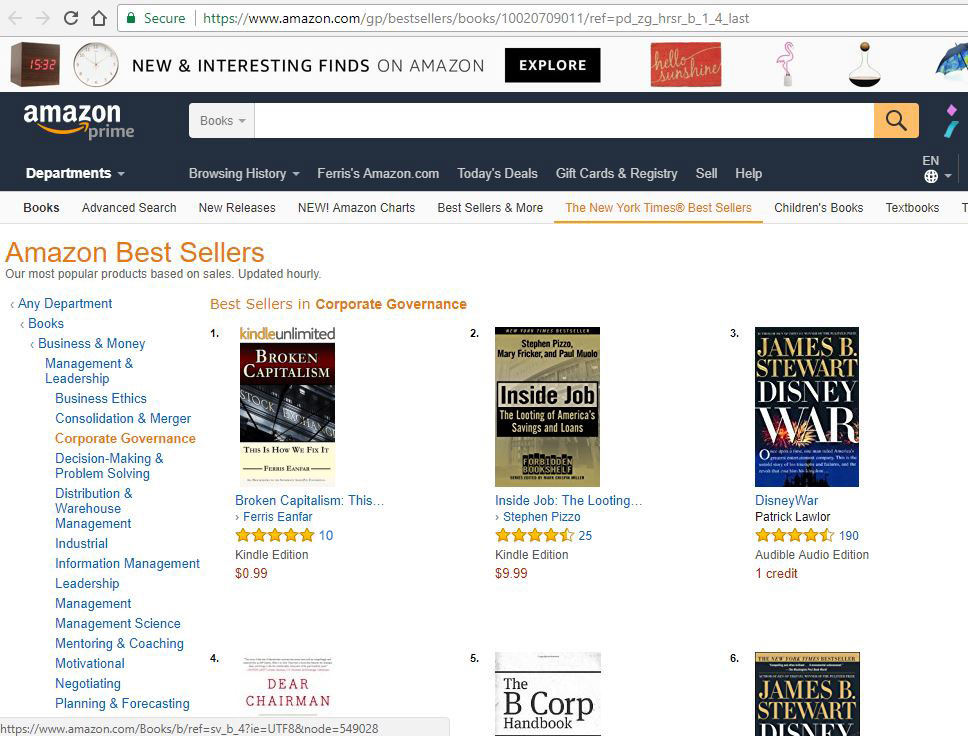In the Beginning. . . American foreign policy has been an influential driver of global economic and geopolitical affairs for over two centuries. After the ratification of the U.S. Constitution in 1788 and throughout most of the 19th Century, the nascent U.S. Government was primarily focused on consolidating its geographical borders and political power within the North American continent. The U.S. was involved in several skirmishes during the Barbary Wars between 1801 and 1815, but those were purely defensive in nature, intended to stop Mediterranean pirates from attacking American merchant vessels. Nevertheless, we can see from those earliest days of the American Experiment that the interests of the government and the interests of corporations were intertwined.
1853: Gunboat Trade & Diplomacy with Japan. The first instance of American offensive action against a foreign power that was focused primarily on commercial goals was in 1853 when U.S. Navy Commodore Matthew Perry led a fleet of warships to Japan’s Edo Bay (Tokyo Bay today). That was the first of a series of aggressive acts to force the Tokugawa regime in Japan to open its commercial markets to American merchants. These events culminated in the Japan–US Treaty of Peace and Amity of 1854, which granted American merchants access to two Japanese ports (Shimoda and Kakodate), currency exchange facilities, most-favored nation status to ensure trade parity with Japan’s other trading partners, among other benefits.[1] Here we see again that U.S. foreign policy was driven by corporate interests.
1893: Overthrow of the Kingdom of Hawaii. According to U.S. congressional testimony (labeled the “Blount Report”), the Queen of the Kingdom of Hawaii in 1893 was forced at gunpoint to abdicate the throne and Hawaii was forced to convert to a constitutional republic.[2] On the surface, that might seem like progress to many people today. However, the Blount Report provided evidence “that officially identified the United States’ complicity in the lawless overthrow of the lawful, peaceful government of Hawaii . . . .”[3] Additionally, “the landing of U.S. Marines under a false or exaggerated pretext” and “the revolution was carried out against the wishes of a majority of the population of Hawaii.” The overthrow was instigated by American sugar plantation owners to increase their profits by avoiding the 1890 McKinley Tariff. Thus, this is another example of corporate interests driving U.S. foreign policy.
1900—2000s: A Century of U.S. Occupation, Exploitation, & Destruction of Cuba. U.S. corporations, with direct support from the U.S. Government, completely controlled Cuba financially and politically for generations. They stripped Cuba of so much wealth that the Cuban people were starving and had no way to escape the stranglehold of their oppressors. More than 80% of the best Cuban farmland was owned by U.S. corporations.[4] According to a U.S. Department of Commerce report, U.S. corporations owned “90% of the telephone and electric services, about 50% in public service railways, and roughly 40% in raw sugar production.”[5] These conditions were directly responsible for the rise of the Castro dictatorship, the spread of communism throughout Latin America, the Bay of Pigs disaster, and the Cuban Missile Crisis.[6] The USG’s actions were so atrocious that the CIA Director of Operations said, “I am afraid we will be repeating the errors we made in 1959 and 1960 when we drove Fidel Castro into the Soviet camp,” when Nixon was contemplating similar atrocities in Chile.[7]
Kennedy Publicly Admitted the USG’s Atrocities. The description above only scratches the surface of the atrocities committed against the Cuban people by U.S. corporations and the USG. In 1960, during his presidential campaign, John F. Kennedy said:
1914-1927: Deploying the Taxpayer-Funded U.S. Military to Protect “Big Business” & “Wall Street”. U.S. General Smedley Butler was the most decorated soldier in American history and the only Marine to be awarded the Brevet Medal and two Medals of Honor. Thus, his credibility is unimpeachable; and there are many other sources that corroborate Butler’s testimony.[9] In Butler’s book, War Is a Racket, he presented a detailed first-person account about how for decades during the first half of the 20th Century he was a hired mercenary deployed by the U.S. Government on behalf of American corporations. In Butler’s own words:
Squandering American Tax Dollars to Protect Corporate Interests Ignites War. There’s nothing wrong with a government protecting its citizens from harm. However, when the U.S. Government extracts over $600 billion per year in taxes from its citizens and uses that money to deploy the U.S. Military as mercenaries to every corner of the planet to protect the offshore assets of a tiny number of banks and corporations, that’s stealing from the American people to subsidize the rich. The general public receives no meaningful benefit from those taxes at all. In fact, Americans receive a net loss because our security is reduced when the U.S. Government colludes with corporations to oppress people in other countries. Obviously, that radicalizes and inspires those people to fight back in the form of reprisal attacks like Pearl Harbor and 9/11. Butler understood these realities, which is why he predicted World War II years before it started:
War Is a Racket. Nobody on Earth during the 20th Century had a more realistic and accurate perspective of the intentions and consequences of the U.S. Government’s actions than Smedley Butler. Butler’s analysis is clear and his conclusions are chilling: War is a racket; and this racket has been the driving force behind U.S. foreign policy for over 100 years. In Butlers own words:
The U.S. Government Antagonizes Foreign Countries. For generations, the U.S. Government has frequently inflamed geopolitical tensions with other countries by building over 1,000 military bases in every other country’s backyard, then conducting war games in their faces.[13] Imagine what Americans living in California, New York, or Florida would think if Russia, China, or any other country were conducting military exercises right in front of their eyes! U.S. politicians say they are protecting us by spending over $600 billion per year of our wealth on these asinine activities, but in reality, they are stealing from us and making us much less safe. Regarding U.S. Military war games right off the Japanese coastline in 1935, Butler again implicitly predicted World War II and sarcastically said:
U.S. Military Bases in Foreign Countries
Source: U.S. Pentagon’s Annual Base Structure Report, et al. Graphic by 5W Infographics.
1933—1970s: The First Global Oil Cartel. In 1933, the Rockefeller-owned oil company, Standard Oil of California (SoCal), executed an oil exploration agreement with Saudi Arabia.[15] A few years later, several other American and British oil companies joined SoCal to form a cartel known as the “Seven Sisters.” For decades, these companies controlled virtually all global oil supply, colluded to fix prices, and dominated the economies and political systems of virtually all Middle Eastern and Southeast Asian countries. They did this by colluding with the U.S. and British Governments to squeeze and manipulate oil-producing countries, support puppet dictators, assassinate political leaders who resisted their control, use the U.S. Military and CIA to enforce grossly lopsided oil profit-sharing agreements, among many other atrocious actions.[16][17][18] After enduring these injustices for decades, virtually every oil-producing country nationalized their oil supply.[19] As a result, today, the oil industry is dominated by a new cartel of state-owned oil companies, including Saudi Aramco, Gazprom (Russia), Petrobras (Brazil), Petronas (Malaysia), China National Petroleum Corp., National Iranian Oil Company, and PDVSA (Venezuela).
A Profitable WWII Joint-Venture. At least a year before the United States was involved in World War II, U.S. oil companies recognized the opportunity to profit by selling oil to both the Allies and the Axis Powers and simultaneously exploit British and Dutch suffering caused by Nazi Germany.[20] By using U.S. participation in the war as a bargaining chip, the oil companies could usurp British and Dutch control of Iranian, Iraqi, and Southeast Asian oil fields. In fact, Roosevelt was publicly enthusiastic about this joint-venture opportunity between the government and the oil companies: During a press conference in January 1940, Roosevelt said, “In carrying on this war, the British may have to part with that control, and we, perhaps, can step in. . . . It is a terribly interesting thing.”[21] This and other evidence suggests that Roosevelt was deliberately trying to provoke the Japanese and Germans to attack the U.S. so that he would have an excuse to declare war. It’s unlikely that he did this purely for the benefit of big corporations, but there is no question that corporate and government interests converged to make the deadliest and most costly war in human history an attractive joint-venture opportunity.
Wasting USD Trillions on Unnecessary Nuclear Bombs. In his book, Command and Control: Nuclear Weapons, the Damascus Accident, and the Illusion of Safety, investigative journalist Eric Schlosser reveals the many deadly disasters, special interest-driven decisions, and politically motivated shenanigans associated with the U.S. nuclear weapons program. His book covers the period between the Eisenhower Administration near the beginning of the Cold War to the Obama Administration after the 2008 Financial Crisis.[22] One of the primary themes in his book: Was it ever necessary to have so many nuclear weapons? To answer this question, Schlosser interviewed hundreds of nuclear technicians, engineers, scientists, and Defense Department officials. Virtually all of them said the same thing: The U.S. nuclear weapons arsenal never should have been so large and should be much smaller today. Yet, USD trillions of taxpayer funds were shoveled into defense companies to build and maintain a grossly wasteful nuclear weapons program.
Unelected Corporate Consultants Dictate Defense Policy & Spending. The U.S. Government’s foreign and military policies are substantially conceived, influenced, and executed by unelected corporate consultants who work at for-profit consulting and defense companies. When confronted about the potential conflicts of interest associated with allowing unelected corporations to have so much power over U.S. foreign and military policies, U.S. politicians typically provide vague statements that can be summarized in the following self-serving loop of logic.
The $1.5 Trillion Airplane & the Insatiable Military-Industrial Complex. After a military weapon (e.g., the $1.5 trillion F-35 Fighter Jet that “broke the U.S. Air Force”) is contracted to be built by a defense company, politicians have strong political incentives to find reasons to justify the cost of the weapon, or else they won’t get re-elected; and the weapons companies, consultants, and their lobbyists have strong commercial incentives to justify the cost of their existence.[23] Both of these symbiotic incentives converge to substantially inflate the significance of various global threats. These toxic incentives also inflate the amount of American taxpayer dollars that Congress allocates to the U.S. defense budget, which inflates the national debt and steals wealth from American citizens. These toxic incentives corrupt and distort U.S. national security policies and encourage U.S. politicians to:
- Find (and fabricate) terrorist threats lurking in every corner of the planet. For example, the entire war in Iraq was based on a single “Nigerian yellow cake uranium transaction” that never actually occurred, which U.S. politicians at the highest level tried to cover up.[24]
- Maintain a nuclear arsenal that is nearly 1,000 times larger than necessary to defend the U.S. homeland.
- Implement mass surveillance programs designed to spy on American citizens via phone systems, banking systems, Internet systems, snail-mail systems, satellite systems, drones, and a sprawling network of law enforcement and intelligence agencies.
- Create constitutionally dubious “Fusion Centers” in every state in America, which are secret offices in American cities designed to spy on American citizens.[25]
- Brainwash Americans with expensive propaganda, e.g., “out-spending the Soviet Union was the reason the U.S. won the Cold War.” In reality, the Soviet Union was corroding from the inside for many other reasons and the U.S. could have spent 1/50th of the amount on nuclear weapons and the Strategic Defense Initiative (aka the “Star Wars Program”) and the USSR would have still collapsed during the early 1990s.
This Is Political & Economic Oppression. Some people say things like, “This is the sacrifice we must make to create the wealthiest country in history.” This is nonsense. Having a well-equipped military for national defense and the defense of any friendly nation would be achieved with a budget 10 times smaller than the U.S. DoD budget today. More importantly, virtually no American votes for this obscenely wasteful, immoral, and unjust militarist regime that controls U.S. foreign policy and steals USD trillions of our wealth. The “wealth” being “created” is the wealth being extracted from the American people into the accounts of gigantic corporations who employ a tiny fraction of the U.S. population. GDP grows just fine in many countries without squandering USD trillions on unnecessary death machines. In fact, the mere existence of weapons like the $1.5 trillion F-35 Fighter Jet and the USD multi-trillion nuclear weapons program are glaring examples of how undemocratic and economically oppressive the U.S. political system has become.
 Is U.S. Foreign Policy Controlled by Corporations? Sometimes it’s difficult to distinguish between corporate interests and government interests because the two beasts are often fused together in a poisonous, anti-democratic, circular ouroboros snake eating its own tail. However, the preponderance of evidence and expert testimony analyzed so far indicates that American foreign policy is driven much more frequently by corporations than by any legitimate democratic process.
Is U.S. Foreign Policy Controlled by Corporations? Sometimes it’s difficult to distinguish between corporate interests and government interests because the two beasts are often fused together in a poisonous, anti-democratic, circular ouroboros snake eating its own tail. However, the preponderance of evidence and expert testimony analyzed so far indicates that American foreign policy is driven much more frequently by corporations than by any legitimate democratic process.
If you are skeptical about any of the claims in this article or anything else at Eanfar.org, see Do You Need More Proof?
Notes:
[1] Jansen, M. B. (2002). The making of modern Japan. Cambridge, MA: Belknap Press of Harvard University Press.
[2] Tate, Merze. (1965). The United States and the Hawaiian Kingdom: A Political History. New Haven and London: Yale University Press. p. 235.
[3] Ball, Milner S. “Symposium: Native American Law,” Georgia Law Review 28 (1979). p. 303.
[4] Monzote, Reinaldo Funes (March 3, 2016). “Sugar Cane and Agricultural Transformations in Cuba”. doi:10.1093/acrefore/9780199366439.001.0001/acrefore-9780199366439-e-4.
[5] U.S. Department of Commerce, Investment in Cuba. (1956). Washington, D.C.: U.S. Government Printing Office.
[6] Johnson, Leland L. (1965-01-01). “U.S. Business Interests in Cuba and the Rise of Castro”. World Politics. 17 (3): 440–459. doi:10.2307/2009288. JSTOR 2009288.
[7] “Make the Economy Scream”: Secret Documents Show Nixon, Kissinger Role Backing 1973 Chile Coup. (2013). http://www.democracynow.org/2013/9/10/40_years_after_chiles_9_11
[8] John F. Kennedy: Speech of Senator John F. Kennedy, Cincinnati, Ohio, Democratic Dinner. (October 6, 1960). http://www.presidency.ucsb.edu/ws/?pid=25660
[9] Dr. Grossman, Z. (n.d.). From Wounded Knee to Syria. https://sites.evergreen.edu/zoltan/interventions
[10] Butler, S. D. (1935). War is a Racket: The Antiwar Classic by America’s Most Decorated Soldier. Los Angeles, Calif: Feral House.
[11] Ibid. p. 25.
[12] Ibid.
[13] Slater, A. (2018, January 24). The US Has Military Bases in 80 Countries. All of Them Must Close. The Nation. https://www.thenation.com/article/the-us-has-military-bases-in-172-countries-all-of-them-must-close
[14] Butler, S. D. (1935). War is a Racket: The Antiwar Classic by America’s Most Decorated Soldier. Los Angeles, Calif: Feral House.
[15] Petroleum Archives Project. Arabian Peninsula & Gulf Studies Program. (n.d.). Oil Company Histories. http://www.virginia.edu/igpr/APAG/apagoilhistory.html
[16] Coll, S. (2013). Private Empire: ExxonMobil and American Power (Reprint edition). New York: Penguin Books.
[17] Kinzer, S. (2008). All the Shah’s Men: An American Coup and the Roots of Middle East Terror (2 edition). Hoboken, N.J: Wiley.
[18] Black, E. (2015). Internal Combustion: How Corporations and Governments Addicted the World to Oil and Derailed the Alternatives by Edwin Black. St. Martin’s Press.
[19] Mapped: The 7 Governments the U.S. Has Overthrown. (n.d.). https://foreignpolicy.com/2013/08/20/mapped-the-7-governments-the-u-s-has-overthrown
[20] Sutton, A. C. (1976). Wall Street and the Rise of Hitler. San Pedro, California: G S G & Associates Pub.
[21] Gardner, Lloyd C. (1964). Economic Aspects of New Deal Diplomacy. Boston: Beacon Press. p. 126.
[22] See Command and Control by Eric Schlosser.
[23] Francis, D. (2014, July 31). How DOD’s $1.5 Trillion F-35 Broke the Air Force. https://www.cnbc.com/2014/07/31/how-dods-15-trillion-f-35-broke-the-air-force.html
[24] Yellowcake forgery – SourceWatch. (n.d.). https://www.sourcewatch.org/index.php/Yellowcake_forgery
[25] Kayyali, D. (2014, April 7). Why Fusion Centers Matter: FAQ. https://www.eff.org/deeplinks/2014/04/why-fusion-centers-matter-faq
About Ferris Eanfar
Ferris Eanfar has over 20 years of experience in technical, financial, media, and government intelligence environments. He has written dozens of articles and several books in the fields of Economics, Crypto-Economics, and International Political Economy, including Broken Capitalism: This Is How We Fix It and GINI: Capitalism, Cryptocurrencies & the Battle for Human Rights and the Global Governance Scorecard. Ferris is a cofounder of the Gini Foundation, which builds unique cryptocurrency systems to protect human rights, among other benefits; and the CEO of the AngelPay Foundation, a nonprofit financial services company with a mission to “return wealth and power to the creators of value.” To learn more about Ferris, please visit the About Ferris page.Visit Ferris on:

 Gini Website Coming Soon. We (
Gini Website Coming Soon. We (
